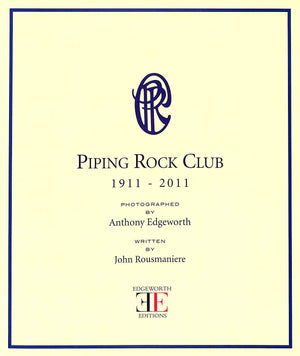"Piping Rock Club 1911-2011" EDGEWORTH, Anthony and ROUSMANIERE, John (SOLD)
Price on Request $450
EDGEWORTH, Anthony [photographed by]
and ROUSMANIERE, John [written by]
[168] pp.
Edgeworth Editions
Limited Edition
Published for the members of PRC on the occasion of their Club's 100th Anniversary.
2011
10 1/4" x 8 3/4"
Fine
Scroll Down for (24) Additional Scans:
The Piping Rock Club 1911-2011 was written by John Rousmaniere, with photography by Anthony Edgeworth. The book was published in a limited edition with a slipcase for the club’s 100 year anniversary. It is their first and only history.
Piping Rock’s original membership rolls were a who’s who of the pre-war establishment including J. P. Morgan, Jr., Louis C. Tiffany, Conde Nast, Averell Harriman, Percy Chubb, John S. Phipps, William Vincent Astor, Cornelius Vanderbilt, and Frank N. Doubleday. President Theodore Roosevelt was an honorary member. In addition to being the course designer, Charles Blair Macdonald, was also a member and chairman of the golf committee.
Piping Rock was established in the model of a classic club of its era, organized to allow its members to enjoy country pursuits. The club was named based on a legend that Native Indians used a large rock on the property as a location to smoke the “pipe of peace,” thus, the piping rock. The Brooklyn Daily Eagle, writing in 1909, described the fact that the property the club secured was done so, “because of its absolute perfection of country sports,” and noted that it was set in “the land of princely estates,” and was ideal for, “providing on a large and elaborate scale for out-of-door sports with polo, pony racing, tennis, and possibly golf, and in any event cross country riding well to the fore.” As noted, the club’s focus was not initially golf; they also established a steeplechase course which included a grandstand for spectators.
Piping Rock today retains the air of its founding days. Driving up to the Dutch Colonial clubhouse flanked by a stone wall gives the visitor a sense of being a country gentleman or lady. The entire scene is one of a leisurely enclave. Nearby the clubhouse are beautifully maintained grass tennis courts. Surrounding the tennis courts, clubhouse, and polo fields is the rolling terrain of the golf course. Like the C.B. Macdonald-designed St. Louis Country Club, the visitor at Piping Rock is also drawn immediately to the prominence of the old polo field behind the clubhouse.
As courses designed by C. B. Macdonald and built by Seth Raynor do, Piping Rock follows their usual “prototype” hole patterns and includes renditions of a Long, Road, Biarritz, Redan, Eden, Knoll, Short, and Home holes.
The book is of a very high quality with Edgeworth’s usual top shelf standards of photographic excellence. It features graceful pictures of the golf course, some taken in the fall with autumn leaves in bloom. And it has pictures of the interior of the historic clubhouse. When the new club commissioned the architect, Guy Lowell, to design the clubhouse their mandate to him was to build, “the sort of thing that George Washington would have built if he had the money.” He didn’t disappoint.
The 168 page book also has lots of historic images of horse races and polo matches held at Piping Rock and pictures of C. B. Macdonald, the Prince of Wales and Bobby Jones, among others, at the club. As befits Piping Rock, it is a stately club history.

















































